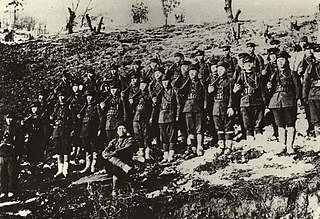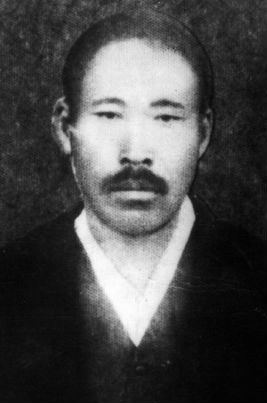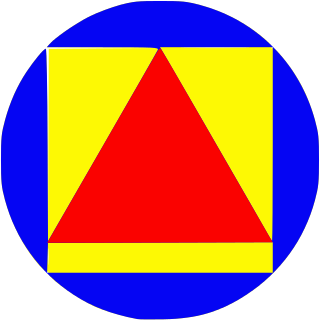Related Research Articles
Jiandao or Chientao, known in Korean as Gando or Kando, is a historical border region along the north bank of the Tumen River in Jilin Province, Northeast China that has a high population of ethnic Koreans. The word "Jiandao", literally "Middle Island", originally referred to a shoal in Tumen River between today's Chuankou Village, Kaishantun in Longjing, Jilin, China and Chongsŏng, Onsong County in North Korea. The island was an important landmark for immigrants from the Korean Peninsula looking for settlements across the river. As the number of immigrants increased, the area covered by the name "Jiandao" gradually changed to reflect the areas of Korean settlement.

The Battle of Qingshanli was fought over six days in October 1920 between the Imperial Japanese Army and Korean armed groups in a densely wooded region of eastern Manchuria called Qīngshānlǐ. It occurred during the campaign of the Japanese army in Jiandao, during the Japanese rule of Korea (1910–1945).
The Gando Special Force was an independent battalion within the Manchukuo Imperial Army composed primarily of ethnic Koreans, and some experienced foreign mercenaries from Asia tasked with suppressing anti-Japanese, and pro-communist militant groups in the border areas between northern Japanese occupied Korea and Manchukuo. It operated between 1 December 1938 and 1945.
The Battle of Fengwudong was a battle between Korean independence militias and Japanese forces in Manchuria. It took place between 6 and 7 June 1920, and was one of the earliest domestic support operations of the Korean independence forces. It was a battle in which independence army units defeated the Japanese regular army in Bongo-dong, Manchuria in 1920. The battle began when the independence armies led by Hong Beom-do and Choi Jin-dong attacked and destroyed the Japanese military police border post. The independence army that lured out the Japanese soldiers killed 120 Japanese soldiers and then carried out an operation to continue luring the Japanese soldiers to Bongo-dong. The independence army, which reorganized the combined forces and was in ambush in the Bongo-dong Valley, opened fire all at once when the Japanese army entered the siege, killing 157 Japanese regular soldiers and injuring about 200 others. The reason for this overwhelming victory was the independence army's heightened morale, the commander's foresight, and excellent operational planning.
The Hunchun incident was a reported raid on 2 October 1920 at a Japanese consulate in Manchuria. It reportedly resulted in the death of thirteen Japanese. The Japanese government used this incident to justify sending thousands of Imperial Japanese troops into Manchuria on 5 October 1920. These escalations culminated with the Battle of Qingshanli between Japan and the Korean Independence Army, where Korean rebels fought Japanese soldiers.

The Korean Empire invasion of Manchuria was an invasion of Manchuria by the Korean Empire. The attack began on 11 August 1902, when Gojong of Korea sent Yi Bum-yun to Jiandao as an observer. The attack ended in victory for Korea, which gained some control over Jiandao until the Gando Convention of 1909.

The Korean Independence Corps (Korean: 대한독립군단) was a militant Korean independence organization that united the Korean Independence armies until its dissolution after the Free City Incident, reorganization in Manchuria, and its final dissolution.

The Korean Independence Army (Korean: 대한독립군) was an independent military force organized in Northern Jiandao (Gando) in 1919 and led by Hong Beom-do, a former gunner. This unit played major roles in defeating the Japanese in the Battle of Fengwudong and Battle of Qingshanli.
The Battle of Samdunja was fought between June 4 and June 6, 1920 on the banks of the Wolshin River in Manchuria between the combined force of the Northern Korean Military Office and the Shinmindan against the Imperial Japanese Army.

The Korean Democratic Corps (Korean: 대한신민단), also known as the Shinminhoe, Daehan Shinminhoe, or Shinmindan, was a Protestant-affiliated armed independence movement group organized in Vladivostok, Primorsky Krai and East Manchuria in March 12, 1919. It was led by Director Kim Gyu-myeon, Vice Director Han Gwang-taek, General Affairs Director Choi Sang-jin, Finance Director Lee Jon-su, and Foreign Affairs Director Kim Deok-bo were appointed.

The Northern Military Administration Office (Korean: 북로군정서) was an armed independence movement group founded in Donggandao in 1919. It originated from the Daejonggyo lineage. It was organized around Seo Il and Kim Jwa-jin in Jilin Province, Manchuria, in 1919. Based on the Junggwangdan organized by Koreans who immigrated to Bukgando, the Jeongjeongdan organized in Bukgando in 1919 was established by changing its name to Northern Military Administration Office. The Northern Military Administration Office established an officer training center to conduct military training and train independence fighters. In 1920, when Japan deployed its troops into Manchuria, it achieved a great victory over the Japanese army in the Battle of Cheongsanri.

The Korean Northern Army Command (Korean: 대한북로독군부) was a union of militant independence groups formed by Hong Beom-do's Korean Independence Army, Cho An-mu's Korean National Army, and Choi Jin-dong's Military Affairs Command in May 1920, and played a leading role in winning the Battle of Fengwudong in June 1920.

The Gangdo National People's Association (Korean: 간도국민회) was a group in the Korean independence movement in Manchuria organized in 1914. It was formed in exile during the Japanese occupation of Korea. While focusing on educational movements such as building elementary schools and middle schools, the March 1st Movement in 1919 began full-scale activities.

The Righteous Government (Korean: 정의부) was an anti-Japanese armed independence movement organization and military government organized in West Jiandao in 1924 through the unification movement of Korean independence groups in Manchuria and as an autonomous organization for Koreans. Yang Gi-tak, Kim Dong-sam, and Ji Cheong-cheon founded its base in the Bongcheon and Jilin provinces. In the mid-1920s, leaders of the Korean independence movement in Manchuria hoped for a grand unification of the independence groups for a more effective anti-Japanese armed struggle. Accordingly, the leaders held several meetings since 1923 and promoted the integration of various organizations. The Righteous Government was established around the same time the General Staff Headquarters, and the Korean People's Association in Manchuria. It is referred to as the third prefecture along with others, and was an organization that led the independence movement in Manchuria in the mid to late 1920s.

Hyŏn Ikch'ŏl was a teacher and a Korean independence activist who served as chairman of the Tongui Department during the Japanese Occupation of Korea, chairman of the central executive committee of the National People's Prefecture, and central executive secretary of the Korean Revolutionary Party, and member of the Military Studies Compilation Committee of the Provisional Government of the Republic of Korea.

The Korean Unification Government (Korean: 대한통의부), previously known as the Unification Military Government, was an independence movement group organized in Manchuria in February 1922 by integrating several independence movement groups active in the West Jiandao region. The Unification Government expanded and reorganized into the Korean Unification Government in August 1922, which was established as the first integrated independence army organization in West Jiandao and revitalized the activities of the independence army, which had been in a temporary stagnation, under the banner of Daedong unity. They carry out the anti-Japanese independence movement more effectively at the South Manchurian Unification Association held in Magwonja, Nam-gu, Hwanin-hyeon, Bongcheon-province. The Korean Unification Government carried out autonomous activities such as education and industry promotion and various armed struggle activities in the West Jiandao region. Due to its nature as a union of various organizations with different backgrounds, a division occurred, and it was divided into the reformed Righteous Army Command, General Staff Headquarters, and Righteous Government.

The Righteous Army Command (Korean: 의군부) was a monarchist independence movement group organized in Manchuria in 1919. Their military foundation was based on the former Righteous Army fighters who escaped to Manchuria after failing to retake Seoul from the Japanese Empire. They were known for fighting alongside militant independence groups at several major battles against the Japanese. When they joined the Korean Unification Government, they came into conflict with them due to ideological differences between monarchism and republicanism which led to several bloody conflicts. Eventually they withdrew from the government to establish themselves as an autonomous organization, but due to the rise in democracy and socialism their power waned and they disbanded to joined the other autonomous organizations.

The Korean Righteous Corps (Korean: 대한정의단) was a short-lived militant Korean independence activist organization from May to October 1919. It was founded as a union of Daejong followers and believers of other religions, such as the Confucian Church. The Korean Justice Corps aimed to carry out a secret armed struggle to achieve independence, and its leader was Seo Il. The Korean Justice Corps contributed to promoting the necessity of the anti-Japanese independence struggle and promoting national consciousness. They reorganized into the Northern Military Government but they changed the name to Northern Military Administration Office under the Provisional Government of the Republic of Korea.

The Korean Righteous Military Administration Office (Korean: 대한정의군정사) was an organization organized by former Korean soldiers and volunteer soldiers who had been directly fighting against the Japanese army with weapons in the country since before the March 1st Movement in 1919. They joined the Korean Independence Corps as the Korean Volunteer Army but was later disbanded due to the Free City Incident.
References
- 1 2 3 4 경신참변 [Gyeongsin Massacre] (in Korean). Academy of Korean Studies . Retrieved 3 March 2018.
{{cite encyclopedia}}:|website=ignored (help) - 1 2 Eckhardt Fuchs, Tokushi Kasahara, Sven Saaler (4 December 2017). A New Modern History of East Asia. V&R unipress GmbH. p. 196. ISBN 978-3737007085 . Retrieved 3 March 2018.
The Japanese forces then carried out the Gando Massacre, in which they indiscriminately attacked Koreans living in Eastern Manchuria and other regions, killing over 5,000 and burning down more than 3,500 homes.
{{cite book}}: CS1 maint: multiple names: authors list (link) - 1 2 Suh, Jae-Jung (7 December 2012). Origins of North Korea's Juche: Colonialism, War, and Development. Lexington Books. p. 50. ISBN 978-0739176597 . Retrieved 3 March 2018.
Within a few months, the Japanese contingent in Jiandao massacred thousands of Koreans in their merciless mopping-up campaign. They concentrated their attacks on Korean villages with well-built Communist organizations and where anti-Japanese sentiment was most intense.
- 1 2 3 4 5 6 7 8 "간도 참변" (in Korean). Encyclopedia of Korean Culture . Retrieved 25 September 2023.
- 1 2 3 4 5 6 "한국 독립군" (in Korean). Encyclopedia of Korean Culture . Retrieved 4 February 2023.
